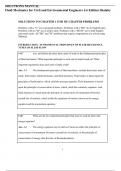SOLUTIONS MANUAL
Fluid Mechanics for Civil and Environmental Engineers 1st Edition Shalaby
SOLUTIONS TO CHAPTER 1 END OF CHAPTER PROBLEMS
Problems with a "C" are conceptual problems. Problems with a "BG" are in English units.
Problems with an "SI" are in metric units. Problems with a "BG/SI" are in both English
and metric units. All "BG" and "SI" problems that require computations are solved using
Mathcad.
INTRODUCTION, FUNDAMENTAL PRINCIPLES OF FLUID MECHANICS,
TYPES OF FLUID FLOW
1-1C List, and define the three basic units of study in the fundamental principles
of fluid mechanics? What important principle is each unit of study based on? What
important equation(s) does each unit of study yield?
Ans. 1-1 The fundamental principles of fluid mechanics include three basic units of
study: fluid statics, fluid kinematics, and fluid dynamics. Fluid statics is based upon the
principles of hydrostatics, which yield the pressure equation. Fluid kinematics is based
upon the principle of conservation of mass, which yields the continuity equation. And,
fluid dynamics is based upon the principle of conservation of momentum (Newton's
second law of motion), which yields the equations of motion, known as the energy
equation and the momentum equation.
1-2C What are the two important principles that may be used do derive the
energy equation?
Ans. 1-2 The energy equation may be derived based on either the principle of
conservation of momentum (Newton's second law of motion), or the principle of
conservation of energy (the first law of thermodynamics).
1
,1-3C The basic unit of study fluid dynamics includes what topic, which yields
the resistance equations?
Ans. 1-3 The basic unit of study fluid dynamics also includes the topic of
dimensional analysis, which yields the resistance equations.
1-4C What is the difference between internal flow and external flow?
Ans. 1-4 Internal flows include pressure (pipe) flow, and gravity (open channel)
flow. External flows include the flow around objects.
1-5C What are the three governing equations in fluid flow?
Ans. 1-5 The three governing equations in fluid flow are the continuity equation,
the energy equation, and the momentum equation.
1-6C What is the difference between the Eulerian approach and the Lagrangian
approach in the application of the governing equations?
Ans. 1-6 The Eulerian approach is an integral approach, and the Lagrangian
approach is a differential approach in the application of the governing equations.
1-7C The energy equation and the momentum equation play complementary
roles in the analysis of a given flow situation. Explain.
Ans. 1-7 Complementary roles mean that when one of the two equations of motion
breaks down, the other may be used to find the additional unknown quantity.
2
,1-8C What determines the type of fluid flow? List the seven classifications of
fluid flow.
Ans. 1-8 The characteristics/properties of a fluid system, along with the fluid
kinematics and fluid dynamics will determine the type of flow. The seven classifications
of fluid flow are: 1) internal vs. external flow, 2) pipe (internal) vs. open channel
(internal) flow, 3) real vs. ideal flow, 4) compressible vs. incompressible flow, 5)
spatially varied (non-uniform) vs. spatially uniform flow, 6) unsteady vs. steady flow,
and 7) one-dimensional vs. two-dimensional vs. three-dimensional flow.
1-9C A real flow may be subdivided into laminar or turbulent flow depending
upon the value of what dimensionless number?
Ans. 1-9 A real flow may be subdivided into laminar or turbulent flow depending
upon the value of the Reynolds number, R = ρvL/µ.
1-10C What are seven important physical properties/characteristics of fluids?
Ans. 1-10 Seven important physical properties/characteristics of fluids include mass
density, specific gravity, specific weight, viscosity, surface tension, vapor pressure, and
bulk modulus.
DIMENSIONS AND UNITS
1-11C What are the four fundamental/primary dimensions used to express the
physical quantities of fluid flow, and the physical properties/characteristics of fluids ?
3
, Ans. 1-11 The four fundamental/primary dimensions used to express the physical
quantities of fluid flow, and the physical properties/characteristics of fluids are: force, F
or mass, M, length, L, time, T, and temperature, θ.
1-12C What does it mean for an equation to be dimensionally homogenous? Give
an example of a dimensionally homogenous equation.
Ans. 1-12 An equation is dimensionally homogenous when the dimensions of each
term of the equation are identical. For example:
Q = vA (the continuity equation)
[LT-3] = [LT-1][L2]
[LT-3] = [LT-3]
1-13C What are two commonly used system of units? What are the primary
dimensions for each system of units? What are units for the primary dimensions for each
system of units?
Ans. 1-13 Two commonly used system of units are the British Gravitational (BG)
(English) system, and the International System (SI) (metric) system. The units for the
primary dimensions in the English system, F, L, T, and θ are pounds, feet, seconds, and
Rankine or Fahrenheit, respectively. The units for the primary dimensions in the metric
system, M, L, T, and θ are kilogram, meter, seconds, and Kelvin or Celsius, respectively.
4




